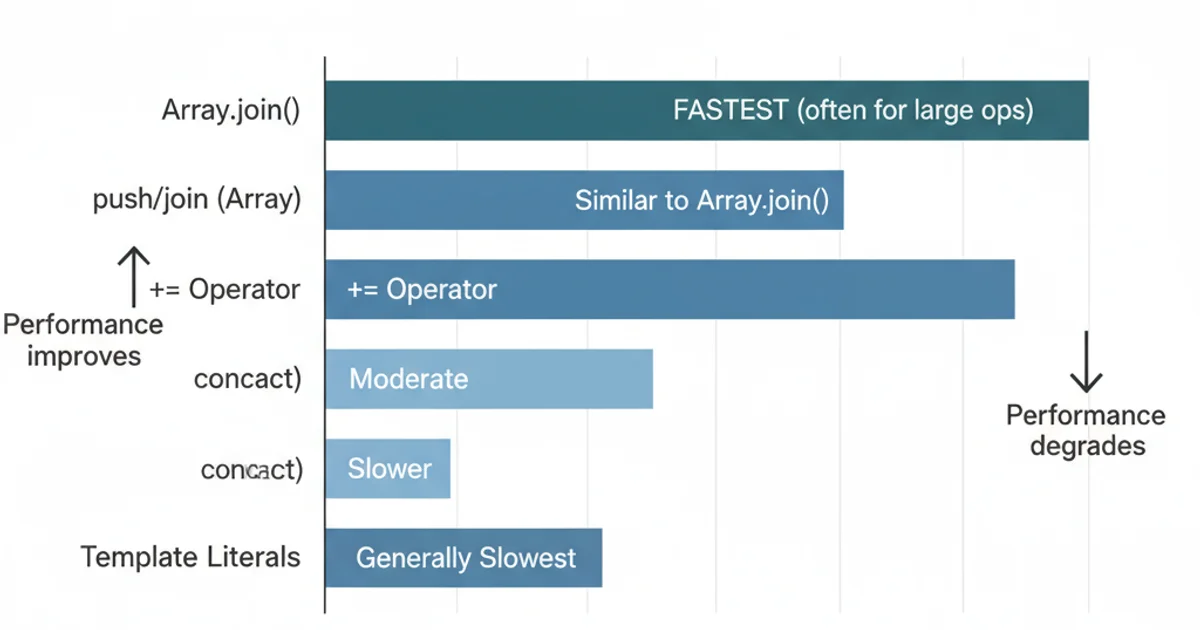Does JavaScript have a built-in stringbuilder class?
Categories:
Does JavaScript Have a Built-in StringBuilder Class?

Explore JavaScript's approach to string concatenation, why a dedicated StringBuilder isn't typically needed, and the most efficient methods for building strings.
Developers coming from languages like Java or C# often look for a StringBuilder class in JavaScript. This is because, in those languages, strings are immutable, and repeated concatenation using the + operator can lead to performance issues due to the creation of many intermediate string objects. JavaScript, however, handles string manipulation differently, making a dedicated StringBuilder class largely unnecessary for most use cases.
Why JavaScript Doesn't Need a StringBuilder
Unlike some other languages, modern JavaScript engines are highly optimized for string concatenation. When you use the + operator or template literals to combine strings, the engine often performs optimizations behind the scenes to avoid creating excessive intermediate strings. This means that what might be inefficient in Java or C# is often optimized away in JavaScript.
flowchart TD
A[Start String Concatenation] --> B{Is it a simple `+` or template literal?}
B -->|Yes| C[JS Engine Optimizes (e.g., pre-allocates memory)]
B -->|No, complex loop/array join| D[Consider Array.join() for performance]
C --> E[Efficient String Creation]
D --> E
E --> F[End String Concatenation]JavaScript String Concatenation Optimization Flow
Common and Efficient String Building Techniques
While there's no StringBuilder class, JavaScript offers several effective ways to build strings. The choice often depends on the specific scenario and personal preference.
1. Template Literals (Template Strings)
Introduced in ES6, template literals provide a clean and readable way to embed expressions within string literals. They are generally the preferred method for constructing strings with dynamic content.
const name = 'Alice';
const age = 30;
const greeting = `Hello, my name is ${name} and I am ${age} years old.`;
console.log(greeting);
// Output: Hello, my name is Alice and I am 30 years old.
Using template literals for string construction.
2. Array.prototype.join()
For scenarios where you need to concatenate a large number of string fragments, especially within a loop, Array.prototype.join() is often the most performant method. You push all string parts into an array and then join them once at the end.
const parts = [];
for (let i = 0; i < 5; i++) {
parts.push(`Item ${i + 1}`);
}
const result = parts.join(', ');
console.log(result);
// Output: Item 1, Item 2, Item 3, Item 4, Item 5
Building a string efficiently with Array.prototype.join().
3. The + Operator
For simple concatenations, the + operator is perfectly fine and readable. Modern JavaScript engines optimize this well, so you don't need to avoid it for small numbers of concatenations.
const firstName = 'John';
const lastName = 'Doe';
const fullName = 'Name: ' + firstName + ' ' + lastName;
console.log(fullName);
// Output: Name: John Doe
Simple string concatenation using the '+' operator.
Array.prototype.join() when dealing with a very large number of dynamic string fragments, typically inside a loop.Performance Considerations
While Array.prototype.join() is often cited as the most performant method for large-scale string building, the performance differences between these methods have become less significant with advancements in JavaScript engine optimizations. Benchmarking your specific use case is always the best way to determine the absolute fastest approach, but for general development, readability and maintainability should often take precedence.

General performance comparison of string building methods (results may vary by engine and scale).